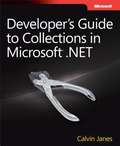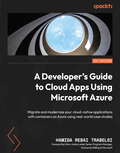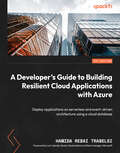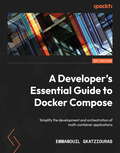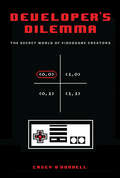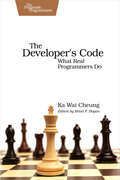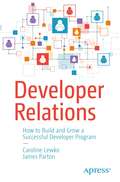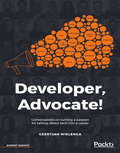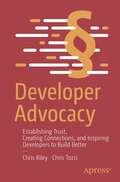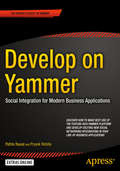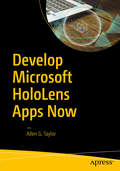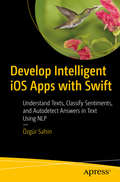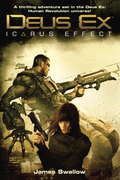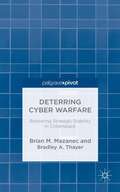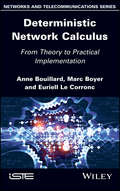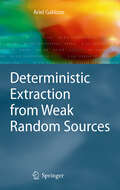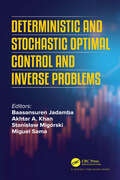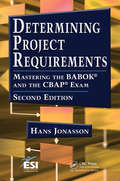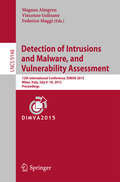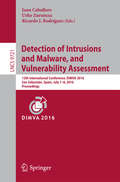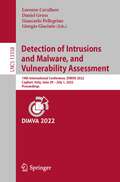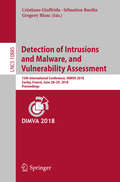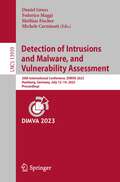- Table View
- List View
Developer's Guide to Collections in Microsoft® .NET
by Calvin Lee" JanesBuild the skills to apply Microsoft® .NET collections effectively Put .NET collections to work--and manage issues with GUI data binding, threading, data querying, and storage. Led by a data collection expert, you'll gain task-oriented guidance, exercises, and extensive code samples to tackle common problems and improve application performance. This one-stop reference is designed for experienced Microsoft Visual Basic® and C# developers--whether you're already using collections or just starting out. Discover how to: Implement arrays, associative arrays, stacks, linked lists, and other collection types Apply built in .NET collection classes by learning their methods and properties Add enumerator, dictionary, and other .NET collection interfaces to your classes Query collections by writing simple to complex Microsoft LINQ statements Synchronize data across threads using built in .NET synchronization classes Enhance your custom collection classes with serialization support Use simple data binding to display collections in Windows® Forms, Microsoft Silverlight®, and Windows Presentation Foundation
A Developer's Guide to Cloud Apps Using Microsoft Azure: Migrate and modernize your cloud-native applications with containers on Azure using real-world case studies
by Hamida Rebai Trabelsi Marc-Andre LanielBuild and deploy modern and secure applications on Microsoft Azure by implementing best practices, patterns, and new technologies with this easy-to-follow guidePurchase of the print or Kindle book includes a free PDF eBookKey FeaturesLearn various methods to migrate legacy applications to cloud using different Azure servicesImplement continuous integration and deployment as a best practice for DevOps and agile developmentGet started with building cloud-based applications using containers and orchestrators in different scenariosBook DescriptionCompanies face several challenges during cloud adoption, with developers and architects needing to migrate legacy applications and build cloud-oriented applications using Azure-based technologies in different environments. A Developer's Guide to Cloud Apps Using Microsoft Azure helps you learn how to migrate old apps to Azure using the Cloud Adoption Framework and presents use cases, as well as build market-ready secure and reliable applications.The book begins by introducing you to the benefits of moving legacy apps to the cloud and modernizing existing ones using a set of new technologies and approaches. You'll then learn how to use technologies and patterns to build cloud-oriented applications. This app development book takes you on a journey through three major services in Azure, namely Azure Container Registry, Azure Container Instances, and Azure Kubernetes Service, which will help you build and deploy an application based on microservices. Finally, you'll be able to implement continuous integration and deployment in Azure to fully automate the software delivery process, including the build and release processes.By the end of this book, you'll be able to perform application migration assessment and planning, select the right Azure services, and create and implement a new cloud-oriented application using Azure containers and orchestrators.What you will learnGet to grips with new patterns and technologies used for cloud-native applicationsMigrate old applications and databases to Azure with easeWork with containers and orchestrators to automate app deploymentSelect the right Azure service for deployment as per the use casesSet up CI/CD pipelines to deploy apps and services on Azure DevOpsLeverage Azure App Service to deploy your first applicationBuild a containerized app using Docker and Azure Container RegistryWho this book is forThis book is for cloud developers, software architects, system administrators, developers, and computer science students looking to understand the new role of the software architect or developer in the cloud world. Professionals looking to enhance their cloud and cloud-native programming concepts will also find this book useful. A sound background in C#, ASP.NET Core, and Visual Studio (any recent version) and basic knowledge of cloud computing will be helpful.
A Developer's Guide to Building Resilient Cloud Applications with Azure: Deploy applications on serverless and event-driven architecture using a cloud database
by Lori Lalonde Hamida Rebai TrabelsiSuccessfully modernize your apps on Azure using APIs, event-driven systems, functions, and Service Fabric and connect them to different relational and non-relational databasesPurchase of the print or Kindle book includes a free PDF eBookKey FeaturesUnderstand Function-as-a-Service and Azure Service Fabric for distributed applicationsDevelop event-based and message-based solutions using Event Grid and Azure Event HubsExplore continuous deployment for Docker with Azure DevOps and integrate Docker Hub with CI/CD pipelinesBook DescriptionTo deliver software at a faster rate and reduced costs, companies with stable legacy systems and growing data volumes are trying to modernize their applications and accelerate innovation, but this is no easy matter. A Developer's Guide to Building Resilient Cloud Applications with Azure helps you overcome these application modernization challenges to build secure and reliable cloud-based applications on Azure and connect them to databases with the help of easy-to-follow examples.The book begins with a basic definition of serverless and event-driven architecture and Database-as-a-Service, before moving on to an exploration of the different services in Azure, namely Azure APIManagement using the gateway pattern, event-driven architecture, Event Grid, Azure Event Hubs, Azure message queues, FaaS using Azure Functions, and the database-oriented cloud. Throughout the chapters, you'll learn about creating, importing, and managing APIs and Service Fabric in Azure, and discover how to ensure continuous integration and deployment in Azure to fully automate the software delivery process, that is, the build and release process.By the end of this book, you'll be able to build and deploy cloud-oriented applications using APIs, serverless, Service Fabric, Azure Functions, and Event Grid technologies.What you will learnUnderstand the architecture of Azure Functions and Azure Service FabricExplore Platform-as-a-Service options for deploying SQL Server in AzureCreate and manage Azure Storage and Azure Cosmos DB resourcesLeverage big data storage in Azure servicesSelect Azure services to deploy according to a specific scenarioSet up CI/CD pipelines to deploy container applications on Azure DevOpsGet to grips with API gateway patterns and Azure API ManagementWho this book is forThis book is for cloud developers, software architects, system administrators, database administrators, data engineers, developers, and computer science students who want to understand the role of the software architect or developer in the cloud world. Professionals looking to enhance their cloud and cloud-native programming concepts on Azure will also find this book useful. A solid background in C#, ASP.NET Core, and any recent version of Visual Studio and basic knowledge of cloud computing, Microsoft Azure, and databases will be helpful when using this book.
A Developer's Essential Guide to Docker Compose: Simplify the development and orchestration of multi-container applications
by Emmanouil GkatziourasStart defining your infrastructure using Docker Compose and leverage it for everyday development or deploymentKey FeaturesDistribute your code in an easier way for developers to get startedSet up complex infrastructure for development and CI/CD purposesDeploy simple multi-container applications using Docker ComposeBook DescriptionSoftware development is becoming increasingly complex due to the various software components used. Applications need to be packaged with software components to facilitate their operations, making it complicated to run them. With Docker Compose, a single command can set up your application and the needed dependencies. This book starts with an overview of Docker Compose and its usage and then shows how to create an application. You will also get to grips with the fundamentals of Docker volumes and network, along with Compose commands, their purpose, and use cases. Next, you will set up databases for daily usage using Compose and, leveraging Docker networking, you will establish communication between microservices. You will also run entire stacks locally on Compose, simulate production environments, and enhance CI/CD jobs using Docker Compose. Later chapters will show you how to benefit from Docker Compose for production deployments, provision infrastructure on public clouds such as AWS and Azure, and wrap up with Compose deployments on said infrastructure. By the end of this book, you will have learned how to effectively utilize Docker Compose for day-to-day development.What you will learnCreate multi-container applications using Docker ComposeUse Docker Compose for daily developmentConnect microservices leveraging Docker network fundamentalsAdd monitoring to services leveraging PrometheusDeploy to production using Docker ComposeTranslate Compose files to Kubernetes deploymentsWho this book is forThis book is for software engineers, developer advocates, and DevOps engineers looking to set up multi-container Docker applications using Compose without the need to set up a Docker orchestration engine. It is also for team leads looking to increase the productivity of an organization's software teams by streamlining the provisioning of complex development environments locally using Docker Compose. Readers are expected to understand containerization and must possess fundamental Docker knowledge to get started with this book.
Developer's Dilemma: The Secret World of Videogame Creators (Inside Technology)
by Casey O'DonnellAn examination of work, the organization of work, and the market forces that surround it, through the lens of the collaborative practice of game development.Rank-and-file game developers bring videogames from concept to product, and yet their work is almost invisible, hidden behind the famous names of publishers, executives, or console manufacturers. In this book, Casey O'Donnell examines the creative collaborative practice of typical game developers. His investigation of why game developers work the way they do sheds light on our understanding of work, the organization of work, and the market forces that shape (and are shaped by) media industries. O'Donnell shows that the ability to play with the underlying systems—technical, conceptual, and social—is at the core of creative and collaborative practice, which is central to the New Economy. When access to underlying systems is undermined, so too is creative collaborative process. Drawing on extensive fieldwork in game studios in the United States and India, O'Donnell stakes out new territory empirically, conceptually, and methodologically. Mimicking the structure of videogames, the book is divided into worlds, within which are levels; and each world ends with a boss fight, a “rant” about lessons learned and tools mastered. O'Donnell describes the process of videogame development from pre-production through production, considering such aspects as experimental systems, “socially mandatory” overtime, and the perpetual startup machine that exhausts young, initially enthusiastic workers. He links work practice to broader systems of publishing, manufacturing, and distribution; introduces the concept of a privileged “actor-intra-internetwork”; and describes patent and copyright enforcement by industry and the state.
The Developer's Code: What Real Programmers Do (Oreilly And Associate Ser.)
by Ka Wai CheungYou're already a great coder, but awesome coding chops aren't always enough to get you through your toughest projects. You need these 50+ nuggets of wisdom. Veteran programmers: reinvigorate your passion for developing web applications. New programmers: here's the guidance you need to get started. With this book, you'll think about your job in new and enlightened ways.The Developer's Code isn't about the code you write, it's about the code you live by.There are no trite superlatives here. Packed with lessons learned from more than a decade of software development experience, author Ka Wai Cheung takes you through the programming profession from nearly every angle to uncover ways of sustaining a healthy connection with your work.You'll see how to stay productive even on the longest projects. You'll create a workflow that works with you, not against you. And you'll learn how to deal with clients whose goals don't align with your own. If you don't handle them just right, issues such as these can crush even the most seasoned, motivated developer. But with the right approach, you can transcend these common problems and become the professional developer you want to be.In more than 50 nuggets of wisdom, you'll learn:Why many traditional approaches to process and development roles in this industry are wrong - and how to sniff them out.Why you must always say "no" to the software pet project and open-ended timelines.How to incorporate code generation into your development process, and why its benefits go far beyond just faster code output.What to do when your client or end user disagrees with an approach you believe in.How to pay your knowledge forward to future generations of programmers through teaching and evangelism.If you're in this industry for the long run, you'll be coming back to this book again and again.
Developer Relations: How to Build and Grow a Successful Developer Program
by Caroline Lewko James PartonIncreasingly, business leaders are either looking to start a new developer program at their company or looking to increase the impact of their existing DevRel program. In this context, software developers are finally recognized as legitimate decision makers in the technology buying process, regardless of the size of their organization. New companies are appearing with the sole purpose of making tools for developers, and even companies whose primary focus was elsewhere are waking up to the developer opportunity. Even as the need and demand for DevRel has grown, there are still re-occurring challenges for DevRel leaders. It is these challenges that this book addresses, covering all aspects of a DevRel program. It is an essential reference to professionalize the practice of developer relations by providing you with strategic, repeatable, and adoptable frameworks, processes, and tools, including developer segmentation and personas, and developer experience frameworks. In Developer Relations, you’ll find the answers to the following questions: How do we convince stakeholders to support a program?How do we go about creating a program?How do we make developers aware of our offer?How do we stand out from the crowd?How do we get developers to use our products?How do we ensure developers are successful using our products?How do we measure success?How do we maintain the support of our stakeholders? After reading this book you’ll have a clear definition of what developer relations is, the type of companies that engage in DevRel, and the scope and business models involved. What You Will Learn Discover what developer relations is and how it contributes to a company’s successLaunch a DevRel program Operate a successful program Measure the success of your programManage stakeholders Who This Book Is For Those interested in starting a new developer program or looking to increase the impact of their existing one. From executives to investors, from marketing professionals to engineers, all will find this book useful to realize the impact of developer relations.
Developer, Advocate!: Conversations on turning a passion for talking about tech into a career
by Geertjan WielengaA collection of in-depth conversations with leading developer advocates that reveal the world of developer relations today Key Features Top developer advocates reveal the work they're doing at the center of their tech communities and the impact their advocacy is having on the tech industry as a whole Discover the best practices of developer advocacy and get the inside story on working at some of the world's largest tech companies Features contributions from noted developer advocates, including Scott Hanselman, Sally Eaves, Venkat Subramaniam, Jono Bacon, Ted Neward, and more Book Description What exactly is a developer advocate, and how do they connect developers and companies around the world? Why is the area of developer relations set to explode? Can anybody with a passion for tech become a developer advocate? What are the keys to success on a global scale? How does a developer advocate maintain authenticity when balancing the needs of their company and their tech community? What are the hot topics in areas including Java, JavaScript, "tech for good," artificial intelligence, blockchain, the cloud, and open source? These are just a few of the questions addressed by developer advocate and author Geertjan Wielenga in Developer, Advocate!. 32 of the industry's most prominent developer advocates, from companies including Oracle, Microsoft, Google, and Amazon, open up about what it's like to turn a lifelong passion for knowledge sharing about tech into a rewarding career. These advocates run the gamut from working at large software vendors to small start-ups, along with independent developer advocates who work within organizations or for themselves. In Developer, Advocate!, readers will see how developer advocates are actively changing the world, not only for developers, but for individuals and companies navigating the fast-changing tech landscape. More importantly, Developer, Advocate! serves as a rallying cry to inspire and motivate tech enthusiasts and burgeoning developer advocates to get started and take their first steps within their tech community. What you will learn Discover how developer advocates are putting developer interests at the heart of the software industry in companies including Microsoft and Google Gain the confidence to use your voice in the tech community Immerse yourself in developer advocacy techniques Understand and overcome the challenges and obstacles facing developer advocates today Hear predictions from the people at the cutting edge of tech Explore your career options in developer advocacy Who this book is for Anybody interested in developer advocacy, the impact it is having, and how to build developer advocacy capabilities
Developer Advocacy: Establishing Trust, Creating Connections, and Inspiring Developers to Build Better
by Chris Riley Chris TozziNo matter which point you're currently at on the developer advocacy journey – whether you've already implemented a developer advocate function or you're exploring the possibility – this book is for you. This book provides actionable guidance that business and technology leaders can use to understand the benefits of advocacy, identify what goes into the function, and learn how to maximize the success of developer advocate teams.Developer advocacy is a role that is sometimes hard to quantify and build – but you feel it when you’re missing it. Companies are struggling to solidify advocacy despite a strong desire to do so and little guidance exists for businesses seeking to build a developer advocacy program or assess its effectiveness. This book will show you how to get an advocacy program in your business: the basics of having an advocacy program, what tasks and processes need to be set up, and how to identify key stakeholders. You'll see how companies of all types that sell to or engage with technical audiences can develop a developer advocacy strategy. Specifically, you'll learn what developer advocates do, how business can start an advocacy practice in your organization and how to scale and operationalize such a practice once it is in place. The book will further explore the metrics for measuring advocacy success and ways the scale advocacy teams internally and externally. The Power of Developer Advocacy explores the exciting career path of advocacy for developers and engineers. What You Will LearnDiscover what developer advocacy isDetermine which sorts of companies need the functionUnderstand what the primary strategic considerations for developer advocacy isWho This Book is For Existing and future advocacy leaders, would-be developer advocates, developer marketers and DevRel teams and leaders
Develop on Yammer
by Pathik Rawal Pryank RohillaDevelop on Yammer is your guide to integrating the Yammer social network with your company's application ecosystem. By developing custom apps and features on the Yammer platform, you can make your workplace more productive, encourage communication and feedback, and get your colleagues collaborating across a range of platforms, including SharePoint, ASP. NET, and Windows Phone. The book begins with an introduction to the development options available along with guidance on how to set up a Yammer developer account. You'll then take your first step in Yammer integration by building a Yammer feed into a web page or other JavaScript-based client application, before diving into app creation and management on the Yammer platform. The authors provide a deep dive into the Yammer authorization process from client-side and server-side perspectives, and you'll find out how to work closely with Yammer's data streams and its full range of development possibilities using Open Graph and Yammer's REST API. The final chapters cover how to build Yammer integration into standalone applications for SharePoint and Windows Phone 8 with Yammer SDKs. All chapters are illustrated with examples and sample code, and a case study follows the development of a workplace training application as the authors apply each technique, so you can see how to make the most of what Yammer has to offer. What you'll learn Why develop on Yammer, and what development options are available How to add a Yammer feed to an HTML-based application using Yammer Embed, to bring relevant news and discussions into the contexts where they matter How to develop custom Yammer features for your SharePoint, Office or web applications on the client side with the Yammer JavaScript SDK How to carry out secure authorization and authentication on Yammer How to use Yammer Open Graph and REST APIs to posts messages, create custom activities and get data from Yammer-integrated applications How to work with the Yammer Windows Phone 8 SDK to add Yammer functionality to a Windows Phone 8 application Who this book is for This book is targeted at developers with a background in . NET/C# development. Readers should be comfortable working with JavaScript. Software architects will also find this book valuable for planning social integration across their companies' business ecosystems. Table of Contents Chapter 1: Introduction to Yammer Development Chapter 2: Yammer Feed Integration with Yammer Embed Chapter 3: Yammer App Development Basics Chapter 4: Authenticating Your Yammer Users Chapter 5: Writing Data into Yammer with Open Graph Chapter 6: Developing Custom Integrations with the Yammer REST API Chapter 7: Build Social Apps Using Yammer's JavaScript SDK Chapter 8: Build Social Apps Using Yammer's Windows Phone 8 SDK
Develop Microsoft HoloLens Apps Now
by Allen G. TaylorThis is the first book to describe the Microsoft HoloLens wearable augmented reality device and provide step-by-step instructions on how developers can use the HoloLens SDK to create Windows 10 applications that merge holographic virtual reality with the wearer's actual environment. Best-selling author Allen G. Taylor explains how to develop and deliver HoloLens applications via Microsoft's ecosystem for third party apps. Readers will also learn how HoloLens differs from other virtual and augmented reality devices and how to create compelling applications to fully utilize its capabilities. What You Will Learn: The features and capabilities of HoloLens How to build a simple Windows 10 app optimized for HoloLens The tools and resources contained in the HoloLens SDK How to build several HoloLens apps, using the SDK tools
Develop Intelligent iOS Apps with Swift: Understand Texts, Classify Sentiments, and Autodetect Answers in Text Using NLP
by Özgür SahinBuild smart apps capable of analyzing language and performing language-specific tasks, such as script identification, tokenization, lemmatization, part-of-speech tagging, and named entity recognition. This book will get you started in the world of building literate, language understanding apps. Cutting edge ML tools from Apple like CreateML, CoreML, and TuriCreate will become natural parts of your development toolbox as you construct intelligent, text-based apps. You'll explore a wide range of text processing topics, including reprocessing text, training custom machine learning models, converting state-of-the-art NLP models to CoreML from Keras, evaluating models, and deploying models to your iOS apps. You’ll develop sample apps to learn by doing. These include apps with functions for detecting spam SMS, extracting text with OCR, generating sentences with AI, categorizing the sentiment of text, developing intelligent apps that read text and answers questions, converting speech to text, detecting parts of speech, and identifying people, places, and organizations in text. Smart app development involves mainly teaching apps to learn and understand input without explicit prompts from their users. These apps understand what is in images, predict future behavior, and analyze texts. Thanks to natural language processing, iOS can auto-fix typos and Siri can understand what you're saying. With Apple’s own easy-to-use tool, Create ML, they’ve brought accessible ML capabilities to developers. Develop Intelligent iOS Apps with Swift will show you how to easily create text classification and numerous other kinds of models. What You'll Learn Incorporate Apple tools such as CreateML and CoreML into your Swift toolbox Convert state-of-the-art NLP models to CoreML from Keras Teach your apps to predict words while users are typing with smart auto-complete Who This Book Is For Novice developers and programmers who wish to implement natural language processing in their iOS applications and those who want to learn Apple's native ML tools.
Deus Ex: Icarus Effect
by James SwallowIT'S NOT THE END OF THE WORLD. BUT YOU CAN SEE IT FROM HERE. In the near future, with physical augmentation gaining ground and nano-cybernetics only years away, the dawn of limitless human evolution is just beyond the horizon, and a secret corporate cabal of ruthless men intends to make sure that humankind stays under its control. But two people on opposite sides of the world are starting to ask questions that could get them killed. Secret Service agent Anna Kelso has been suspended for investigating the shooting that claimed her partner's life. Anna suspects that the head of a bio-augmentation firm was the real target, and against orders she's turned up a few leads concerning a covert paramilitary force and a cadre of underground hackers. But the cover-up runs deep, and now there's a target on her back. Meanwhile, Ben Saxon, former SAS officer turned mercenary, joins a shadowy special ops outfit. They say they're a force for good, but Saxon quickly learns that the truth is not so clear-cut. So begins a dangerous quest to uncover a deadly secret that will take him from Moscow to London, D. C. to Geneva, and to the dark truth--if he lives that long. The year is 2027; in a world consumed by chaos and conspiracy, two people are set on a collision course with the most powerful and dangerous organization in history--and the fate of humanity hangs in the balance.
Detonado não-oficial de Super Smash Bros Wii U, Dicas, Truques, e Segredos do Jogo
by Michel Pinheiro Joshua Abbott*Guia Não-Oficial* Guia de Estratégias e Dicas Avançadas. Este é o mais abrangente e o único guia detalhado que você vai encontrar online. Disponível para download instantâneo em seu celular, dispositivo de eBook ou em papel.
Deterring Cyber Warfare: Bolstering Strategic Stability in Cyberspace
by Brian M. Mazanec Bradley A. ThayerWhile the deterrence of cyber attacks is one of the most important issues facing the United States and other nations, the application of deterrence theory to the cyber realm is problematic. This study introduces cyber warfare and reviews the challenges associated with deterring cyber attacks, offering key recommendations to aid the deterrence of major cyber attacks.
Deterministic Network Calculus: From Theory to Practical Implementation
by Anne Bouillard Marc Boyer Euriell Le CorroncDeterministic network calculus is a theory based on the (min,plus) algebra. Its aim is to compute worst-case performance bounds in communication networks. Our goal is to provide a comprehensive view of this theory and its recent advances, from its theoretical foundations to its implementations. The book is divided into three parts. The first part focuses on the (min,plus) framework and its algorithmic aspects. The second part defines the network calculus model and analyzes one server in isolation. Different service and scheduling policies are discussed, particularly when data is packetized. The third part is about network analyses. Pay burst only once and pay multiplexing only once phenomena are exhibited, and different analyses are proposed and compared. This includes the linear programming approaches that compute tight performance bounds. Finally, some partial results on the stability are detailed.
Deterministic Extraction from Weak Random Sources
by Ariel GabizonA deterministic extractor is a function that extracts almost perfect random bits from a weak random source. In this research monograph the author constructs deterministic extractors for several types of sources. A basic theme in this work is a methodology of recycling randomness which enables increasing the output length of deterministic extractors to near optimal length. The author's main work examines deterministic extractors for bit-fixing sources, deterministic extractors for affine sources and polynomial sources over large fields, and increasing the output length of zero-error dispersers. This work will be of interest to researchers and graduate students in combinatorics and theoretical computer science.
Deterministic and Stochastic Optimal Control and Inverse Problems
by Baasansuren JadambaInverse problems of identifying parameters and initial/boundary conditions in deterministic and stochastic partial differential equations constitute a vibrant and emerging research area that has found numerous applications. A related problem of paramount importance is the optimal control problem for stochastic differential equations. This edited volume comprises invited contributions from world-renowned researchers in the subject of control and inverse problems. There are several contributions on optimal control and inverse problems covering different aspects of the theory, numerical methods, and applications. Besides a unified presentation of the most recent and relevant developments, this volume also presents some survey articles to make the material self-contained. To maintain the highest level of scientific quality, all manuscripts have been thoroughly reviewed.
Determining Project Requirements: Mastering the BABOK and the CBAP Exam (Esi International Project Management Ser.)
by Hans JonassonGood requirements do not come from a tool, or from a customer interview. They come from a repeatable set of processes that take a project from the early idea stage through to the creation of an agreed-upon project and product scope between the customer and the developer.From enterprise analysis and planning requirements gathering to documentation,
Detection of Intrusions and Malware, and Vulnerability Assessment
by Magnus Almgren Vincenzo Gulisano Federico MaggiThis book constitutes the refereed proceedings of the 12th International Conference on Detection of Intrusions and Malware, and Vulnerability Assessment, DIMVA 2015, held in Milan, Italy, in July 2015. The 17 revised full papers presented were carefully reviewed and selected from 75 submissions. The papers are organized in topical sections on attacks, attack detection, binary analysis and mobile malware protection, social networks and large-scale attacks, Web and mobile security, and provenance and data sharing.
Detection of Intrusions and Malware, and Vulnerability Assessment
by Juan Caballero Urko Zurutuza Ricardo J. RodríguezThis book constitutes the refereed proceedings of the 13th International Conference on Detection of Intrusions and Malware, and Vulnerability Assessment, DIMVA 2016, held in San Sebastián, Spain, in July 2016. The 19 revised full papers and 2 extended abstracts presented were carefully reviewed and selected from 66 submissions. They present the state of the art in intrusion detection, malware analysis, and vulnerability assessment, dealing with novel ideas, techniques, and applications in important areas of computer security including vulnerability detection, attack prevention, web security, malware detection and classification, authentication, data leakage prevention, and countering evasive techniques such as obfuscation.
Detection of Intrusions and Malware, and Vulnerability Assessment: 19th International Conference, DIMVA 2022, Cagliari, Italy, June 29 –July 1, 2022, Proceedings (Lecture Notes in Computer Science #13358)
by Lorenzo Cavallaro Daniel Gruss Giancarlo Pellegrino Giorgio GiacintoThis book constitutes the proceedings of the 19th International Conference on Detection of Intrusions and Malware, and Vulnerability Assessment, DIMVA 2022, held in Cagliari, Italy, in June – July 2021. The 10 full papers and 1 short paper presented in this volume were carefully reviewed and selected from 39 submissions.
Detection of Intrusions and Malware, and Vulnerability Assessment: 15th International Conference, DIMVA 2018, Saclay, France, June 28–29, 2018, Proceedings (Lecture Notes in Computer Science #10885)
by Cristiano Giuffrida Sébastien Bardin Gregory BlancThis book constitutes the refereed proceedings of the 15th International Conference on Detection of Intrusions and Malware, and Vulnerability Assessment, DIMVA 2018, held in Saclay, France, in June 2018. The 17 revised full papers and 1 short paper included in this book were carefully reviewed and selected from 59 submissions. They present topics such as malware analysis; mobile and embedded security; attacks; detection and containment; web and browser security; and reverse engineering.
Detection of Intrusions and Malware, and Vulnerability Assessment: 20th International Conference, DIMVA 2023, Hamburg, Germany, July 12–14, 2023, Proceedings (Lecture Notes in Computer Science #13959)
by Daniel Gruss Federico Maggi Mathias Fischer Michele CarminatiThis book constitutes the proceedings of the 20th International Conference on Detection of Intrusions and Malware, and Vulnerability Assessment, DIMVA 2023, held in Hamburg, Germany, in July 2023. The 12 full papers and 1 short paper presented in this volume were carefully reviewed and selected from 43 submissions. The papers are organized in thematical sections named: Side Channels Attacks; Security and Machine Learning; Cyber Physical System Security; Security Issues when Dealing with Users; Analysis of Vulnerable Code; Flow Integrity and Security.
Detection of Intrusions and Malware, and Vulnerability Assessment: 13th International Conference, DIMVA 2016, San Sebastián, Spain, July 7-8, 2016, Proceedings (Lecture Notes in Computer Science #9721)
by Juan Caballero, Urko Zurutuza and Ricardo J. RodríguezThis book constitutes the refereed proceedings of the 13th International Conference on Detection of Intrusions and Malware, and Vulnerability Assessment, DIMVA 2016, held in San Sebastián, Spain, in July 2016. The 19 revised full papers and 2 extended abstracts presented were carefully reviewed and selected from 66 submissions. They present the state of the art in intrusion detection, malware analysis, and vulnerability assessment, dealing with novel ideas, techniques, and applications in important areas of computer security including vulnerability detection, attack prevention, web security, malware detection and classification, authentication, data leakage prevention, and countering evasive techniques such as obfuscation.
